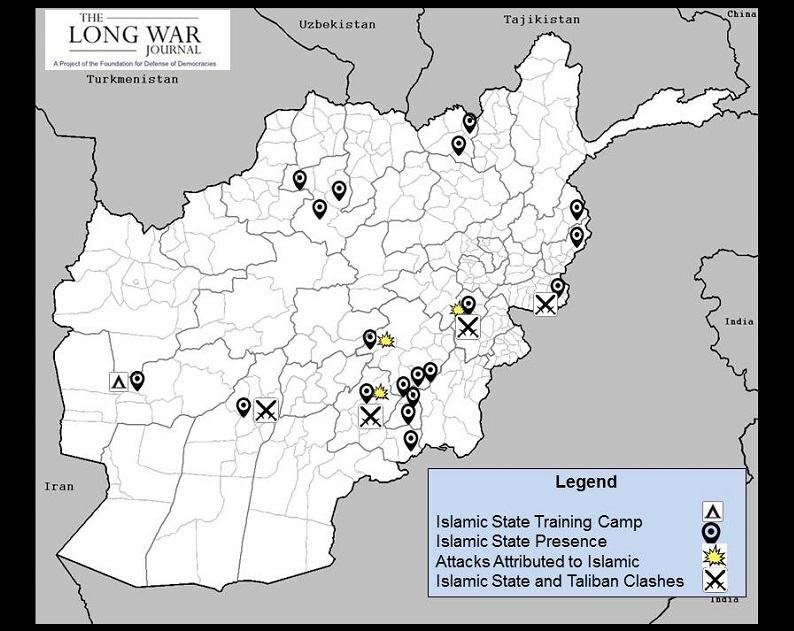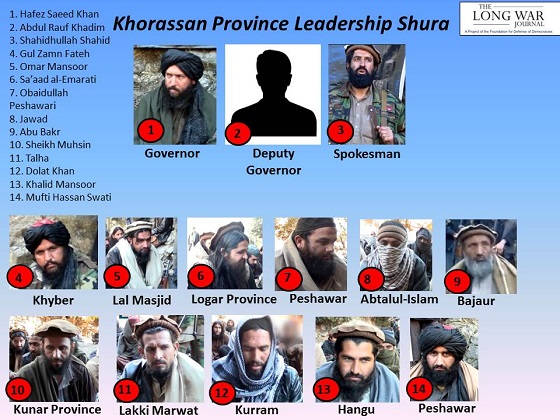Ever since disaffected Afghan and Pakistani Taliban insurgents began pledging allegiance to the Islamic State during the summer of 2014, rumors and reports have emerged indicating how the Islamic State has expanded its presence throughout South Asia. A chronological narrative of the rise of the jihadist group in Afghanistan follows below and the above graphic depicts its emergence.
In late September 2014, fierce battles raged between Afghan security forces and insurgents reported to be associated with the Islamic State in the Arjistan district of Ghazni province. At the time, Afghan officials reported that the insurgents had raised the black flag of the Islamic State and were burning down homes and beheading captured security forces and local residents alike. The incident in Arjistan is mired in controversy, as local Afghan officials allegedly recanted their versions of events and admitted to embellishing the presence of Islamic State fighters as a ploy to obtain more resources, according to a report by The New York Times.
It should also be noted that in early February 2015, the Chief of Police for Ghazni denied that the Islamic State had created a presence in the area, stating that the insurgents fighting against the Afghan Government were local Taliban members.
In mid-October 2014, a small group of disaffected Pakistani Taliban commanders, including the Movement of the Taliban in Pakistan’s Emir for Arakzai Agency, announced their initial pledge to the Islamic State. [See Long War Journal report, Discord dissolves Pakistani Taliban coalition]
In January 2015, the same disgruntled Pakistani Taliban leaders, this time joined by a few little-known disaffected Afghan Taliban commanders, published a propaganda video pledging allegiance to the Islamic State. Within days of the video’s release, the Islamic State announced its expansion into “Khorassan Province” and officially appointed Hafiz Saeed Khan as the Wali (Governor) of Khorassan. The Islamic State also appointed former Guantanamo Bay detainee and senior Taliban leader Mullah Abdul Rauf Khadim as Khan’s deputy. While Khan was primarily responsible for Islamic State activities in the tribal areas of Pakistan, Khadim was based in Helmand province, particularly in his native village located in Kajaki district. It did not take long before clashes broke out between Khadim’s supporters and their rivals belonging to local Taliban factions.
In southwestern Afghanistan, former Taliban insurgents who defected to the Islamic State established a training camp in Farah province in mid-January and were reportedly operating between Bakwa and Khak-e Safid districts. The Islamic State faction in Farah was reportedly led by two brothers, Abdul Malik, who was also known as Mansur, and Abdul Raziq, according to an in-depth report by Pajhwok Afghan News.
Also in mid-January, in northern Sar-i-Pul province, local officials reported that insurgents had raised the black flag of the Islamic State in Kohistanat district and other insurgents had begun recruitment activities on behalf of the jihadist group in the nearby Darzab district of Jawzjan province. Afghan security commanders in Jawzjan later estimated that some 600 insurgents had raised the black flag and were now fighting on behalf of the Islamic State in Jawzjan.
Similar reports emerged from Kunduz province, and the Kunduz governor estimated that nearly 70 insurgents affiliated with the Islamic State had “started activities” in Dasht-e Archi and Chaharadarah districts.
Afghan officials in Ghazni and Paktika Provinces announced in mid-January that hundreds of foreign fighters associated with the Islamic State had recently entered areas of eastern Afghanistan posing as refugees. According to the officials, some 200 foreign nationals had entered the Nawa and Gilan districts of Ghazni and raised the black flag, and 850 families, including Arabs, Pakistanis, and Chechens, had entered Pakitka and Zabul provinces disguised as refugees, some of whom later established households in the Nawbahar, Ab Band, and Shamulzai districts of Zabul.
On February 9, Khadim was killed in a drone strike in Helmand province. [See Long War Journalreport, US kills Islamic State’s deputy emir for ‘Khorasan province’ in airstrike.]



No comments:
Post a Comment